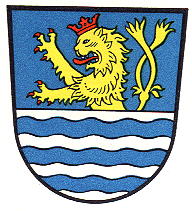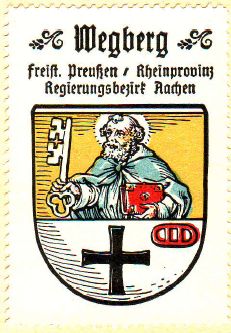Wegberg: Difference between revisions
Knorrepoes (talk | contribs) m (Text replacement - "{{de}}" to "") |
Knorrepoes (talk | contribs) m (Text replacement - "|'''English''' ↵| {{blazon wanted}}" to "|'''English''' | blazon wanted") |
||
| Line 16: | Line 16: | ||
|- | |- | ||
|'''English''' | |'''English''' | ||
| | | blazon wanted | ||
|} | |} | ||
Revision as of 10:32, 7 April 2023
WEGBERG
State : Nordrhein-Westfalen
District (Kreis) : Heinsberg (until 1972 Selfkantkreis)
Additions : 1935 Beeck, 1972 Arsbeck, Wildenrath
| German | Einen goldenen Lö wen auf blauem Grund, darunter drei blaue Wellenbalken auf silbernem Grund. |
| English | blazon wanted |
Origin/meaning
The arms were officially granted onApril 14, 1937.
The upper part of the arms shows the lion of Geldern, as the area belonged to the Duchy of Geldern. The lower part shows wavy bars and represents the former municipality of Beek (Beek means Bach, or stream, brook). The arms were not changed after the merger.
Hupp showed the arms in the 1920s different arms, shown below, which are based on the oldest known seal of the village, dating from the 16th century. The city adopted the composition in the new seal in the early 20th century and Hupp added the colours, which have no historical meaning. The upper part shows St. Peter, the lower a cross. Most likely both refer to the State of Köln (black cross, St. Peter is patron saint of Köln). Next to the saint is a small bread, as during the middle ages, the church distributed small breads to the people.
| Seal from around 1900 |
The arms by Hupp in the Kaffee Hag albums +/- 1925 |
Literature: Stadler, 1964-1971, 8 volumes; Hupp, O: Kaffee Hag albums, 1920s


